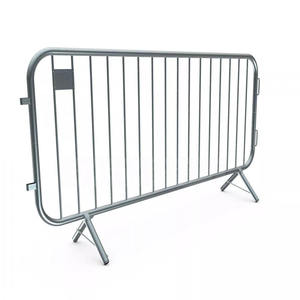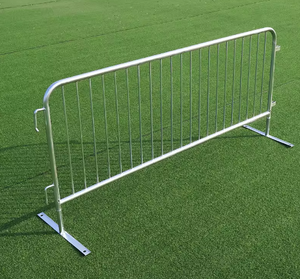
All categories
Featured selections
Trade Assurance
Buyer Central
Help Center
Get the app
Become a supplier

(344 products available)













































Folding Barricades
A folding road barricade is easily foldable for storage and transport. These barricades are often lightweight yet sturdy, designed for quick deployment in events, construction projects, or emergency situations. Their collapsible nature allows for convenient handling, making them ideal for temporary use where space and mobility are crucial.
Plastic Barricades
Barricades made of plastic represent a durable and lightweight option for road security. Often hollow and fillable with sand or water, these barricades offer resilience against severe weather. Due to their lightweight nature, they are easily movable and best suited for temporary blockades or events.
Metal Barricades
Compared to plastic barricades, metal barricades are stronger and offer more security. They can resist adverse weather conditions and major impact forces, making them suitable for long-term blocking. However, cheaper options may be seen, though heavier and often requiring more effort for installation and transport.
Traffic Cones
Traffic cone barricades are well known and often used as temporary road marking during repairs or events. Most are made of plastic and are light enough to be moved easily. Traffic cones are sometimes fitted with reflective tape, boosting visibility at night or in low-light situations.
Rope Barricades
Assembling portable barriers with ropes enables quick setting up. These barriers are nice-looking and useful for restricting access at events, theatres, and exhibitions. Although aesthetically pleasing, their efficiency in traffic control is not as powerful as folding or plastic barricades.
Materials
Cheap road barricades can be made of plastic, metal, wood, and concrete, among other materials. While plastics are lightweight, metal offers exceptional strength, wooden barricades are heavy and solid, and concrete provides ultimate stability. Choosing material according to the purpose and setting where the barricade will be used is necessary.
Dimensions
Barricades come in a variety of sizes depending on their intended use. A common barricade's height may range from 33 cm to 1 meter, while its length could be as long as 2 meters. Custom dimensions are sometimes available for specific projects. Such size adjustments help achieve visibility and line of sight as required.
Water or Sand Fillable Bases
Barricade bases are designed to fill with water or sand for added stability. When using, ensure the fill material is properly drained after use to extend lifetime. Periodically inspect the base for cracks or damages, especially those subjected to harsh climates or continual movement.
Reflectors and Visibility Enhancements
Many barricades have reflectors or bright colors to improve visibility. Check all reflectors and colors for fading or wear, especially before seasons of low visibility, like winter. Clean them regularly to remove dirt or grime, which may obscure visibility and reflections.
Durability and Lifetime Expectancy
Road barricades should be designed for different usage durabilities. Thin barricades may last a couple of months, and more hard-wearing ones may serve for more than a year. Proper usage, storage, and maintenance increase the longevity of barricades as required for projects.
Storage
Proper storage for road barricades when not in use increases their lifetime. Clean the barricade and store it in a cool, dry location away from direct sunlight. For foldable or traffic cone barricades, make sure they are stashed in such a way they will not sag or be distorted.
Construction Zones
Roadwork barriers indicate hazardous locations on streets. They block off unsafe areas where construction is ongoing, protecting pedestrians and cars from risky situations. Their presence makes people conscious of possible dangers, hence reducing accidents.
Emergency Situations
Barricades are life-saving tools in most emergency situations. They help place emergency vehicles, blocking off unsafe areas and guiding people toward safe routes. During fires, disasters, or accidents, these barricades aid emergency teams in doing their operations safely and quickly.
Traffic Control
Authorities use temporary traffic barricades to control and redirect vehicle flows when necessary. These are useful when roads must be closed for events such as parades or races. Properly placed barricades help prevent gridlocks by easily directing vehicles along alternative routes.
Event Management
Barricades manage foot traffic and designate the areas where access is restricted during public events or gatherings. They create a safety perimeter for certain areas, enable easy flow of attendees, and assure that no unauthorized individuals go to areas where work is being carried out.
Parking Control
Road barricades for parking control designate or control certain parking areas. They may block off specific areas to restrict parking or direct cars into designated spaces. This eliminates parked cars from cluttering areas and maximizes parking space usage efficiently.
School Zones
Cheap barricades positioned around the school zones promote safety during entry and dismissal periods. They restrict vehicle access, allowing parents and students to cross the roads safely. Barricades also emphasize speed restrictions and safe walking conditions.
Temporary Road Closures
Cheap barricades can easily announce and support temporary road closures. They effectively communicate with drivers about such closures, thus minimizing confusion. Without such barricades, drivers may unknowingly drive into blocked roads, generating frustration and even hazardous situations.
Assess the intended use
Consider the purpose for which the road barricade will be used. Determine if it will be for temporary applications like events or for long-term use due to construction work. Knowing the requirements will help decide burden, strength, and height needed for the barricade.
Material selection
Materials barricades are made of range from plastic and metal to wood and concrete. Plastic barricades are relatively lightweight and easy to handle, while wooden barricades provide solid support. Plastic and metal barricades have the best durability since they might last longer than disposables.
Visibility and safety features
Choose a barricade featuring bright colors and reflective tape to improve visibility. Safety is also enhanced by adding blinking lights. Enhanced visibility and safety characteristic features ensure people notice the barricades from a distance, especially at bad light.
Portability and storage
If the barricades are intended for temporary use, portability becomes a key factor. Select collapsible or lightweight barricades that can easily be transferred. Also, look at how easy it is to store them while not in use because little space will be consumed during storage.
Cost and budget considerations
Cheap road barricades do not always compromise quality. Outline a budget and stick to it. Do a market comparison regarding prices and value. Occasionally, buying in bulk invites discounts, especially for big projects or multiple events when larger quantities are required.
Size and height
The ideal size and height of the barricade to be put in place depend mostly on the application. Road barricades, commonly employed in safety applications, should be tall enough to catch attention and emphasize barriers. Consider the event's or project's specific requirements where visibility and accessibility are crucial when selecting.
Environment and weather conditions
Considerations for the environment where the barricade will be placed, as well as possible weather conditions, are essential. Take, for example, if the area experiences major winds and rains, select a more solid and stable barricade. For sunny regions, opt for a plastic barricade that won't be damaged due to intense sunlight exposure.
Road barricades are constructed to enhance safety by restricting access to hazardous areas, controlling traffic flows, and marking construction sites. They provide a visual and physical barrier for pedestrians and motorists to alert them to possible dangers on the roadway.
Yes, plastic barricades are durable. Plastics are weather-resistant and the maintainence-free nature of plastics ensures that plastic road barricades can effectively withstand rain, snow, heat, and general environmental conditions. Because of their light weight, they are portable.
Road barricades must effectively be visible and easily recognized by passing pedestrians and motorists. Bright colors such as orange or yellow, and reflective materials further enhance visibility, especially at low-light hours. Efficiency in visibility ensures safety by alerting individuals of the existing road hazards.
It is true that some road barricades, like those manufactured with metal or concrete, will not be classified as eco-friendly. Nonetheless, there are several eco-friendly barricade options, such as the use of some plastics with recycled content. Another option is sustainable wood, which can be recycled once the life cycle of the product comes to an end.
The strength is based on the type of material and the design used to construct the barricade. Concrete and metal barricades are more solid and can withstand vehicle impacts which might be heavy. Typically, collapsible or folding barricades are lightweight and meant for applications less requiring strength.